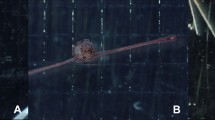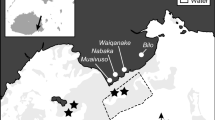Abstract
Although sediment deposition has detrimental effects on macroalgal settlement and recruitment, fucoid algae (mainly Sargassum duplicatum) thrive on rocky reefs always overlaid with fine sediments in sheltered sites of Kagoshima, Japan. The aim of the present study was to assess their ability to settle and recruit onto sediment-covered substrata. A transplant experiment using boulders with Sargassum juveniles attached showed that the 30-day survival rate was as high as 50% even for the juvenile stage (<10 mm) on boulders completely buried with sediment. In addition, an outdoor tank experiment testing the effects of different sediment thicknesses (0–4 mm) on already settled 4-day old S. duplicatum germlings indicated significant reductions in growth by the presence of sediment cover even at 0.5 mm but no significant increase in mortality up to 2 mm. Furthermore, an in situ experiment in which sterilized cobbles were placed at a sediment-covered site to allow sediment to settle over them before the embryo release showed a uniformly high recruitment of Sargassum over the cobbles. This suggests the presence of unknown mechanisms to allow the settlement of propagules on substrata thinly but completely covered by fine sediments.






Similar content being viewed by others
References
Airoldi L (2003) The effects of sedimentation on rocky coast assemblages. Oceanogr Mar Biol Annu Rev 41:161–236
Airoldi L, Cinelli F (1997) Effects of sedimentation on subtidal macroalgal assemblages: an experimental study from a Mediterranean rocky shore. J Exp Mar Biol Ecol 215:269–288
Ang POJ (1985) Regeneration studies of Sargassum siliquosum J. Ag. and S. paniculatum J. Ag. (Phaeophyta, Sargassaceae). Bot Mar 28:231–235
Arakawa H, Matsuike K (1992) Influence on insertion of zoospores, germination, survival, and maturation of gametophytes of brown algae exerted by sediments. Nippon Suisan Gakkaishi 58:619–625
Bates D, Maechler M (2009) lme4: linear mixed-effects models using S4 classes. R package version 0.999375-32. http://CRAN.R-project.org/package=lme4. Accessed 5 Feb 2010
Chapman ARO (1995) Functional ecology of fucoid algae: twenty-three years of progress. Phycologia 34:1–32
Daly MA, Mathieson AC (1977) The effects of sand movement on intertidal seaweeds and selected invertebrates at bound rock, New Hampshire, USA. Mar Biol 43:45–55
D’Antonio CM (1986) Role of sand in the domination of hard substrata by the intertidal alga Rhodomela larix. Mar Ecol Prog Ser 27:263–275
Devinny JS, Volse LA (1978) Effects of sediments on the development of Macrocystis pyrifera gametophytes. Mar Biol 48:343–348
Hurlbert SH (1984) Pseudoreplication and the design of ecological field experiments. Ecol Monogr 54:187–211
Kawamata S (2004) NLRAna v6.6d. http://www.vector.co.jp/soft/win95/business/se104065.html. Accessed 24 Apr 2004
Kawamata S (2009) AreaQ. http://cse.fra.affrc.go.jp/matasan/home_page.html. Accessed 2 Sept 2009
Kawamata S, Yoshimitsu S, Tanaka T, Igari T, Tokunaga S (2011) Importance of sedimentation for survival of canopy-forming fucoid algae in urchin barrens. J Sea Res 66:76–86
Littler MM, Martz DR, Littler DS (1983) Effects of recurrent sand deposition on rocky intertidal organisms: importance of substrate heterogeneity in a fluctuating environment. Mar Ecol Prog Ser 11:129–139
McCook LJ (1996) Effects of herbivores and water quality on Sargassum distribution on the central Great Barrier Reef: cross-shelf transplants. Mar Ecol Prog Ser 139:179–192
McCook LJ, Chapman ARO (1992) Vegetative regeneration of Fucus rockweed canopy as a mechanism of secondary succession on an exposed rocky shore. Bot Mar 35:35–46
Moss BL, Mercer S, Sheader A (1973) Factors affecting the distribution of Himanthalia elongata (L.) S. F. Gray on the north-east coast of England. Estuar Coast Mar Sci 1:233–243
Norton TA (1978) The factors influencing the distribution of Saccorhiza polyschides in the region of Lough Ine. J Mar Biol Assoc UK 58:527–536
Norton TA (1983) The resistance to dislodgement of Sargassum muticum germlings under defined hydrodynamic conditions. J Mar Biol Assoc UK 63:181–193
R Development Core Team (2009) R: a language and environment for statistical computing. R Foundation for Statistical Computing, Vienna, Austria. http://www.R-project.org. Accessed 5 Feb 2010
Schiel DR, Wood SA, Dunmore RA, Taylor DI (2006) Sediment on rocky intertidal reefs: effects on early post-settlement stages of habitat-forming seaweeds. J Exp Mar Biol Ecol 331:158–172
Shirley EA (1977) A nonparametric equivalent of Williams’ test for contrasting increasing dose levels of a treatment. Biometrics 33:386–389
Szewzyk U, Holmstrom C, Wrangstadh M, Samuelsson M-O, Maki JS, Kjelleberg S (1991) Relevance of the exopolysaccharide of marine Pseudomonas sp. strain S9 for the attachment of Ciona intestinalis larvae. Mar Ecol Prog Ser 75:259–265
Terawaki T, Nozawa K, Shinmura I (1983) Studies on morphogenesis in the early stages of Sargassum (Phaeophyceae, Fucales). IV. Sargassum duplicatum. Jpn J Phycol 31:190–195
Trowbridge CD (1992) Mesoherbivory: the ascoglossan sea slug Placida dendritica may contribute to the restricted distribution of its algal host. Mar Ecol Prog Ser 83:207–220
Umar MJ, McCook LJ, Price IR (1998) Effects of sediment deposition on the seaweed Sargassum on a fringing coral reef. Coral Reefs 17:169–177
Vadas RL, Johnson S, Norton TA (1992) Recruitment and mortality of early post-settlement stages of benthic algae. British Phycol J 27:331–351
Venables WN, Ripley BD (2002) Modern applied statistics with S, 4th edn. Springer, New York
Williams DA (1986) A note on Shirley’s nonparametric test for comparing several dose levels with a zero-dose control. Biometrics 42:183–186
Acknowledgments
This study was supported by the Japan Ministry of Agriculture, Forestry and Fisheries through the Operating Grant to the Fisheries Research Agency. We thank T. Igari for assistance with field works.
Author information
Authors and Affiliations
Corresponding author
Additional information
Communicated by F. Bulleri.
Rights and permissions
About this article
Cite this article
Kawamata, S., Yoshimitsu, S., Tokunaga, S. et al. Sediment tolerance of Sargassum algae inhabiting sediment-covered rocky reefs. Mar Biol 159, 723–733 (2012). https://doi.org/10.1007/s00227-011-1849-6
Received:
Accepted:
Published:
Issue Date:
DOI: https://doi.org/10.1007/s00227-011-1849-6




